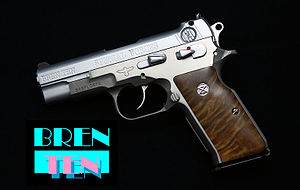Bren Ten
| Bren Ten | |
|---|---|

Bren Ten pistol by Dornaus & Dixon
|
|
| Type | Semi-automatic pistol |
| Place of origin | United States |
| Production history | |
| Designer | Michael Dixon, Thomas Dornaus |
| Designed | 1983 |
| Manufacturer | Dornaus & Dixon Enterprises, Inc. |
| Produced | 1983–1986 |
| No. built | 1,500 |
| Variants | Bren Ten Compact Models Bren Ten Pocket Model |
| Specifications | |
| Weight | 38 oz (1,100 g) (Standard Models) 28 oz (790 g) (Pocket Model) |
| Length | 8.75 in (222 mm) (Standard Models) 7.75 in (196.9 mm) (Compact Models) 6.90 in (175.3 mm) (Pocket Model) |
| Barrel length | 5.00 in (127.0 mm) (Standard Models) 4.00 in (101.6 mm) (Compact Models) 3.75 in (95.3 mm) (Pocket Model) |
| Width | 1.25 in (31.8 mm) (Standard Models, Compact Models) 1.00 in (25.4 mm) (Pocket Model) |
| Height | 5.75 in (146.1 mm) (Standard Models, Compact Models) 5.12 in (130.0 mm) (Pocket Model) |
|
|
|
| Cartridge |
10mm Auto .45 ACP (11.43x23 mm) .22 Long Rifle (conversion kit) |
| Action | Browning short recoil, vertically tilting barrel |
| Effective firing range | 40 m |
| Feed system | 8, 10, 11, 13, 14, 15, 17 or 20-round box magazine |
| Sights | Adjustable 3-dot type; rear notch, front blade |
The Bren Ten is a semi-automatic pistol chambered for 10mm Auto that was made by Dornaus & Dixon Enterprises Inc. from 1983 to 1986. While the Bren Ten's design has an appearance similar to the 9×19mm Parabellum CZ-75, it was larger and stronger with several unique design elements that made it a distinctly separate firearm. The design was produced only in small numbers before the company went bankrupt. Subsequent attempts to bring the firearm back into production have been unsuccessful.
The Bren Ten remains a weapon of some controversy. Many enthusiasts consider it to be one of the best pistols of its era, and the 10mm Auto is one of the most powerful semi-automatic pistol rounds. Issues reported with the gun when it was in its original production run included some of the units delivered with missing or inoperable magazines. Spare magazines were hard to find and were relatively expensive. The 10mm Auto caliber was at first unique to this pistol, and produced initially by FFV Norma AB of Åmotfors, Sweden.
In the 1970s the police and some military forces used a mix of semi-automatic designs and revolvers. Automatics offered high rates of fire and quick reloading, but generally used small rounds that would neither overstress the mechanism nor the shooter. Revolvers were offered in calibers with considerably more power than the automatics, but held only a small number of rounds and were fairly slow to reload. Neither could be considered ideal.
On December 13, 1979, Thomas Dornaus and Michael Dixon decided to start the development of a new semi-automatic pistol to address the gap between revolvers and automatics. What was needed, they believed, was a semiautomatic pistol with its greater ammunition capacity and faster reloads, but one that would deliver power exceeding both the .45 ACP and the .357 Magnum. They hoped the new design would become as popular as the then-aged Colt 1911.
On January 15, 1980, they went seeking advice from the most knowledgeable sources available. This effort led to Jeff Cooper. Upon seeking his advice, the two discovered that he had already been working on such a pistol. The trio combined their efforts: Dornaus and Dixon provided the engineering, development, manufacturing, and marketing, while Cooper provided conceptual design criteria and technical advice. The company was formally incorporated as Dornaus & Dixon Enterprises Inc. on July 15, 1981 in California, and a new factory was set up in Huntington Beach.
...
Wikipedia
